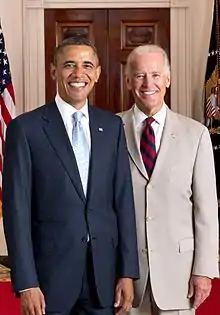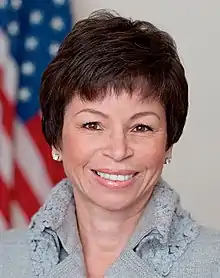White House Task Force to Protect Students from Sexual Assault
The White House Task Force to Protect Students from Sexual Assault was formed on January 22, 2014, after President Barack Obama directed the Office of the Vice President of the United States and the White House Council on Women and Girls to "strengthen and address compliance issues and provide institutions with additional tools to respond to and address rape and sexual assault".[1][2][3] The Task Force is part of a wider federal move to bring awareness to sexual violence on American campuses, which also included the Office for Civil Rights release of a list of American higher education institutions with open Title IX sexual violence investigations and the It's On Us public awareness campaign. The co-chairs of the Task Force are Vice President Joe Biden and Senior Advisor to the President Valerie Jarrett.[1]
| Council overview | |
|---|---|
| Formed | January 22, 2014 |
| Jurisdiction | United States |
| Headquarters | White House |
| Employees | 9+ |
| Council executives |
|
| Parent Council | Office of the Vice President of the United States and White House Council on Women and Girls |
Background and history



While formed through an official government memorandum on January 22, 2014, the White House Task Force to Protect Students from Sexual Assault exists as part of a lineage of government interventions against sexual violence, notably the White House Council on Women and Girls formed in 2009 and the Violence Against Women Act first drafted by Biden when he was a senator in 1994.[4] Simultaneously, activists within The New Campus Anti-Rape Movement have pushed for legislative changes in the ways the U.S. government enforces regulations, as demonstrated in the collaborations between nationally recognized activists and U.S. senators.[5]
Data published in a 2014 government report on sexual assault in American colleges and universities reflects the numbers and backgrounds of college students who have experienced sexual assault.
In the January 2014 report, "Rape and Sexual Assault: A Renewed Call to Action," an overview of findings about sexual assault of college and university students was provided, as follows:
- 1) Women and girls are the vast majority of victims: nearly 1 in 5 women – or nearly 22 million – have been raped in their lifetimes.[6]
- 2) Men and boys, however, are also at risk: 1 in 71 men – or almost 1.6 million – have been raped during their lives.
- 3) Women of all races are targeted, but some are more vulnerable than others: 33.5% of multiracial women have been raped, as have 27% of American Indian and Alaska Native women, compared to 15% of Hispanic, 22% of Black, and 19% of White women.
- 4) Most victims know their assailants.
- 5) The vast majority (nearly 98%) of perpetrators are male.
- 6) Young people are especially at risk: nearly half of female survivors were raped before they were 18, and over one-quarter of male survivors were raped before they were 10. College students may be particularly vulnerable — one study found that 1 in 5 undergraduate women has been sexually assaulted while in college.[7]
- 7) Undergraduate women are at greatest risk of being sexually assaulted during the freshman and sophomore years.[8]
- 8) Repeat victimization is common: over a third of women who were raped as minors were also raped as adults.
- 9) Other populations are also at higher risk of being raped or sexually assaulted, including people with disabilities, the LGBT community, prison inmates (of both genders), and the homeless. Undocumented immigrants face unique challenges, because their abusers often threaten to have them deported if they try to get help.[4]
A report published in January 2015 by the Bureau of Justice Statistics, the result of a nine-school pilot to conduct a campus study on "school-level data on sexual victimization of undergraduate students," found that
- Younger students (between 18–22 years of age) experienced sexual victimization at a rate higher than those 23 or older[9]
- Non-heterosexual students are more likely to be victimized than heterosexual students at the nine schools surveyed[10]
- On average, the rate of victimization for completed sexual assault among undergraduate females was 176 per 1,000 [11]
- On average, the rate of victimization for rape among undergraduate females was 54 per 1,000[12]
Responsibilities
The Task Force was created to protect students from sexual assault, to help improve the safety of American college and university campuses, and to help American colleges and universities to "meet their obligations" and be in compliance with federal regulations in this area.[1][2][3]
Specifically, a listing of the mission and functions of the Task Force are as follows, as quoted directly from Obama's January 22, 2014 Memorandum:
- (a) The Task Force shall work with agencies to develop a coordinated Federal response to campus rape and sexual assault. The functions of the Task Force are advisory only and shall include making recommendations to meet the following objectives:
- (i) providing institutions with evidence-based best and promising practices for preventing and responding to rape and sexual assault;
- (ii) building on the Federal Government's existing enforcement efforts to ensure that institutions comply fully with their legal obligations to prevent and respond to rape and sexual assault;
- (iii) increasing the transparency of the Federal Government's enforcement activities concerning rape and sexual assault, consistent with applicable law and the interests of affected students;
- (iv) broadening the public's awareness of individual institutions' compliance with their legal obligation to address rape and sexual assault; and
- (v) facilitating coordination among agencies engaged in addressing rape and sexual assault and those charged with helping bring institutions into compliance with the law.
- (b) In accordance with applicable law and in addition to regular meetings, the Task Force shall consult with external stakeholders, including institution officials, student groups, parents, athletic and educational associations, local rape crisis centers, and law enforcement agencies.
- (c) Because rape and sexual assault also occur in the elementary and secondary school context, the Task Force shall evaluate how its proposals and recommendations may apply to, and may be implemented by, schools, school districts, and other elementary and secondary educational entities receiving Federal financial assistance.[1]
The Action Plan of the Task Force, also as provided for in Obama's January 22, 2014 Memorandum, includes the following:
- (a) Within 90 days of the date of this memorandum, the Task Force shall develop and submit proposals and recommendations to the President for:
- (i) providing examples of instructions, policies, and protocols for institutions, including: rape and sexual assault policies; prevention programs; crisis intervention and advocacy services; complaint and grievance procedures; investigation protocols; adjudicatory procedures; disciplinary sanctions; and training and orientation modules for students, staff, and faculty;
- (ii) measuring the success of prevention and response efforts at institutions, whether through compliance with individual policies or through broader assessments of campus climate, attitudes and safety, and providing the public with this information;
- (iii) maximizing the Federal Government's effectiveness in combatting campus rape and sexual assault by, among other measures, making its enforcement activities transparent and accessible to students and prospective students nationwide; and
- (iv) promoting greater coordination and consistency among the agencies and offices that enforce the Federal laws addressing campus rape and sexual assault and support improved campus responses to sexual violence.
- (b) Within 1 year of the date of this memorandum, and then on an annual basis, the Task Force shall provide a report to the President on implementation efforts with respect to this memorandum.[1]
By 2016, the Task Force, in collaboration with federal agencies, produced training, messaging and guidance materials "concerning sexual assault in educational spaces," which can be found in a public-facing Resource Guide.[13]
Members
Obama specified in his official memorandum those people who are to be members of the Task Force.[1] Those individuals include Joe Biden or his designee; Valerie Jarrett or her designee; the Attorney General; the Secretary of the Interior; the Secretary of Health and Human Services; the Secretary of Education; the Director of the Office of Science and Technology Policy; the Director of the Domestic Policy Council; the Cabinet Secretary; and agency or office heads as may be designated by the co-chairs.[1]
Joe Biden
Joe Biden's goal from the campaign is to prevent sexual assault. He also strives to create less discrepancies with sexual assault, calling for a future in which a victim of sexual assault does not need to question his or her doing. Biden issued federal guidelines while presenting a speech at the University of New Hampshire. He stated that, "No means no, if you're drunk or you're sober. No means no if you're in bed, in a dorm or on the street. No means no even if you said yes at first and you changed your mind. No means no."
Biden has taken a stance on sexual assault, making speeches to students, asking them to stand against assault.[14] Biden stated to the victim of sexual assault at Stanford University, "you did it... in the hope that your strength might prevent this crime from happening to someone else. Your bravery is breathtaking."[14]
References
- Memorandum: Establishing White House Task Force to Protect Students from Sexual Assault, WhiteHouse.gov, Washington, DC: The White House, 22 January 2014, Retrieved 10 June 2014.
- A renewed call to action to end rape and sexual assault, The White House Blog , Washington, DC: Valerie Jarrett, 22 January 2014, Retrieved 24 January 2014.
- Obama admin: Freedom from sexual assault a basic human right, MSNBC.com, New York, NY: NBC Universal, 22 January 2014, Richinick, M., Retrieved 24 January 2014.
- Rape and sexual assault: A renewed call to action, White House Council on Women and Girls, Washington, DC: White House Council on Women and Girls & Office of the Vice President, January 2014, Retrieved 10 June 2014.
- Vingiano, Alison (July 30, 2014). "On Wednesday, a group of eight senators introduced legislation to confront sexual violence against college students". Buzzfeed. Retrieved August 11, 2014.
- Black, M.C., Basile, K.C., Breiding, M.J., Smith, S.G., Walters, M.L., Merrick, M.T., Chen, J., & Stevens, M.R. (2011). The National Intimate Partner and Sexual Violence Survey (NISVS): 2010 Summary Report. Atlanta, GA: National Center for Injury Prevention and Control, Centers for Disease Control and Prevention. In Rape and sexual assault: A renewed call to action, White House Council on Women and Girls, Washington, DC: White House Council on Women and Girls & Office of the Vice President, January 2014, Retrieved 10 June 2014.
- Krebs, C.P., Lindquist, C.H., Warner, T.D., Fisher, B.S., & Martin, S.L. (2009). College Women's Experiences with Physically Forced, Alcohol- or Other Drug-Enabled, and Drug-Facilitated Sexual Assault Before and Since Entering College. Journal of American College Health, 57(6), 639-647.
- Krebs, C.P., Lindquist, C.H., Warner, T.D., Fisher, B.S., & Martin, S.L. (2007). The Campus Sexual Assault (CSA) Study. Washington, DC: National Institute of Justice, U.S. Department of Justice.
- "Campus Climate Survey Validation Study" (PDF).
- "Campus Climate Survey Validation Study" (PDF).
- "Campus Climate Survey Validation Study" (PDF).
- "Campus Climate Survey Validation Study" (PDF).
- "Prioritizing School Safety: A New Curriculum for Colleges and Universities to Address Sexual Assault". August 12, 2016. Retrieved September 6, 2016.
- White, Daniel (2016). "Joe Biden To Stanford Sexual Assault Victim: 'A Lot Of People Failed You". Time Magazine. Retrieved December 29, 2017.